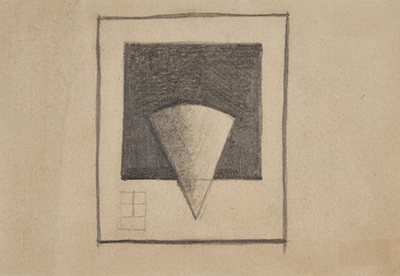Elements were limited down to simple shapes by Malevich during the 1910s and he would also practice his ideas within a number of study drawings, one of which is displayed here.
This is amongst the most simple of Malevich drawings, of all those that have been discovered since he passed away around a century ago. A very strong border contains this design within a larger paper page. A square is filled in with dark charcoal which immediates dominates the scene, with a rounded triangle then shaded in over the top. We instantly have a flat object contrasting with this depth and curved nature of the triangle, and then Malevich adds a further element of detail below with a sort of grid. We are unsure as to the meaning, if any, of these items but can appreciate the simplicity of this experiment, at a time when art was supposed to follow more traditional approaches. There is almost a mathematical theme to this piece, and mathematics would be useful to a number of artists during the early 20th century, when before it had been more limited to the discipline of architecture instead.
It seems remarkable that an artist could be so groundbreaking with such simplicity, but that was entirely the beauty of the work of artists like this in the early 20th century. It just seemed extraordinary for anyone to work in this way, because, quite simply, it had done been done before. Today anyone working in this way will be regarded as unoriginal, perhaps even without talent, but one has to place Malevich's career within the context of art history in order to really understand the merit and originality of what he was doing. The same can be said for the Impressionists of several decades earlier, whose style we now entirely take for granted in a similar manner.
Malevich was not the only highly significant artist to appear from Eastern Europe during the first half of the 20th century. Marc Chagall, a colleague of his at times in his career, gave us some extraordinary artworks such as Autumn in the Village, Self-Portrait with Seven Fingers and The Promenade. He remains one of the most loved European artists in history, and was also integral to building up a following for modern art styles. His style was certainly different to that of Maelvich, but they shared a lot of common ground with regards the desire for a new direction within art that pushed things onwards from the Impressionist and Post-Impressionist eras, taking the benefits of those and adding brand new ideas on top. Ultimately, the challenges and barriers that they faced during that time was worthwhile, as their legacies have passed the test of time.




